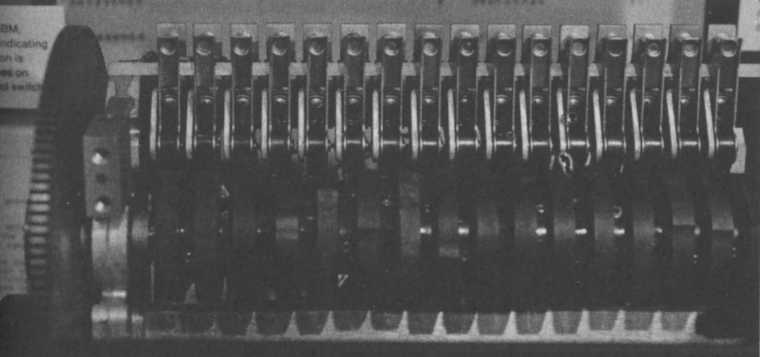Interconnected
Punched Card Equipment
The first
automated scientific computations


Dr. Eckert said in a 1964 interview [51], "It was a revolutionary thing, because up until that time general scientific computing always involved hand work. The numbers had to be copied. The arithmetic had to be done at best with a desk calculator or with logarithms, and here for the first time you could do general things such as the solution of a differential equation completely automatically and you never had to read or write a number."
L.J. Comrie performed scientific computations using punch-card equipment some years earlier (beginning in 1928) at H.M. Nautical Almanac Office, Greenwhich, England. Comrie's method was a great improvement in both speed and accuracy over hand copying. Comrie's calculations were done one step at a time. Manual intervention was required to transfer intermediate results punched onto cards to subsequent reading stations and/or to swap or rewire control panels between steps. Eckert's method was the first to enable a complex series of calculations to be "programmed" to run to completion, an idea first envisioned by Charles Babbage 100 years earlier.
In fact Eckert's 1934 calculations were not entirely automatic; a modest amount of operator intervention was required as described on pages 108-111 of [50], owing mainly to limitations of the original switchbox and machines. However, the principals of automatic sequencing had been established, and were carried forward and fully realized in the Aberdeen machines (1944), SSEC (1946), Card Programmed Calculator (1948), and NORC (1954). (And of course also, independently, in ASCC (Harvard Mark 1), ENIAC et al., but these were done with full knowledge of Eckert's pioneering work.) As Pugh says [40], "this cam-sequenced calculator was a pioneering early step toward stored-program digital computers."
Herb Grosch clarifies the manual intervention: Eckert "used the ... 601 as a desk calculator, passing one [time step] card -- or at some stages, three: one each for x,y,z -- through a cycle of plugboards, which was actually a single in-place control panel the wiring of which was modified by the master circuit breaker in his custom-built "switch". Each step on the switch changed the 601 op, usually by selecting as an input the field just punched as an output on the preceding step. Eckert then re-fed the card (he told me he sat on a strategically-placed stool and extended his reach with a clothespin on a short rod!). Then he cycled to the next switch position, re-re-fed the poor abused card, and so on."
Also see: L.J. Comrie.
References:
- Comrie, L.J., "On the Construction of Tables by Interpolation", Monthly Notices of the Royal Astronomical Society, Vol. 88, pp. 518-521 (1928).
- Comrie, L.J., "The application of the Hollerith Tabulating Machine to Brown's Tables of the Moon", Monthly Notices of the Royal Astronomical Society, Vol. 92, No.7, pp.694-707 (1932).
- Eckert, W.J., "Numerical Integration wiht the Aid of Hollerith Machines", Publications of the American Astronomical Society, Vol.8, No.1, p.9 (1934).
- Eckert, W.J., "Miscellaneous Research Applications: Astronomy", in Baehne, G.W. (ed.) Practical Applications of the Punched Card Method in Colleges and Universities, Columbia University Press (1935).
- Eckert, W.J., "The Computation of Special Perturbations by the Punched Card Method", The Astronomical Journal, Vol.XLIV, No.20, Albany NY (24 Oct 1935).
- Eckert, W.J., Punched Card Methods in Scientific Computation, The Thomas J. Watson Astronomical Computing Bureau, Columbia University, Lancaster Press, Inc., Lancaster PA (January 1940). "The Orange Book." Reprinted in 1984 by the Charles Babbage Institute, MIT, and Tomash Publishers with a new introduction by J.C. McPherson.
- An Interview with Stephen Dunwell, OH 153, Conducted by William Asprey, Charles Babbage Institute, Center for the History of Information Processing, University of Minnesota, Minneapolis, 13 February 1989 (pages 30-31).
Translations of this page courtesy of...
| Language | Link | Date | Translator | Organization |
|---|---|---|---|---|
| Belarusian | Беларуская | 2023/08/22 | Vladyslav Byshuk | Владислав Бишук | studycrumb.com |
| French | Français | 2023/08/31 | Kerstin Schmidt | prothesiswriter.com |
| German | Deutsch | 2023/08/31 | Kerstin Schmidt | writemypaper4me.org |
| Hungarian | Magyar | 2023/08/31 | Kerstin Schmidt | https://writemyessay4me.org/ |
| Italian | Italiano | 2023/08/31 | Kerstin Schmidt | https://admission-writer.com/ |
| Norwegian | Norsk (Bokmål) | 2023/06/11 | Stian Skjelbred | Nye Kasino |
| Polish | Polski | 2023/08/31 | Kerstin Schmidt | justdomyhomework.com |
| Spanish | Español | 2023/08/31 | Kerstin Schmidt | https://pro-academic-writers.com/ |
| Russian | Русский | 2023/08/22 | Vladyslav Byshuk | Владислав Бишук | skyclinic.ua |
| Ukrainian | Українська | 2023/08/22 | Vladyslav Byshuk | Владислав Бишук | studybounty.com |